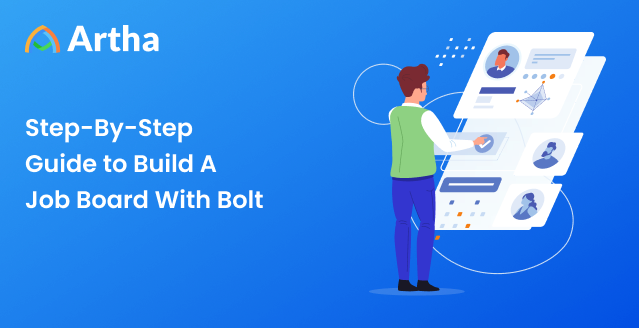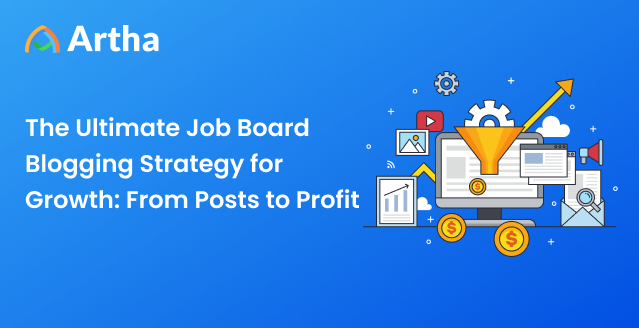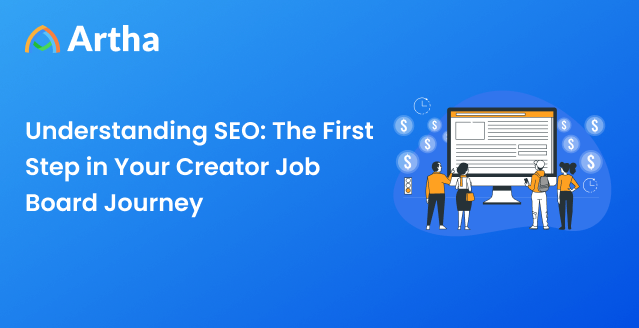Introduction: Why Metrics Matter for Job Boards
Did you know that job boards with data-driven strategies generate 3 times more income than those that don’t?
Sounds great, right? But here’s the catch—not all job board owners know which data to track, let alone how to use it to grow their platform.
Take James as an example. He started a job board for SDR role jobs, thinking it would be a goldmine. Employers would rush in, post job listings, and job seekers would apply like crazy. And for a while, it seemed to be working—traffic was decent, companies were signing up, and jobs were getting posted. But then, something weird happened.
Applications were low. Employers weren’t sticking around. Renewals? Barely happening. James was scratching his head, wondering where he went wrong.
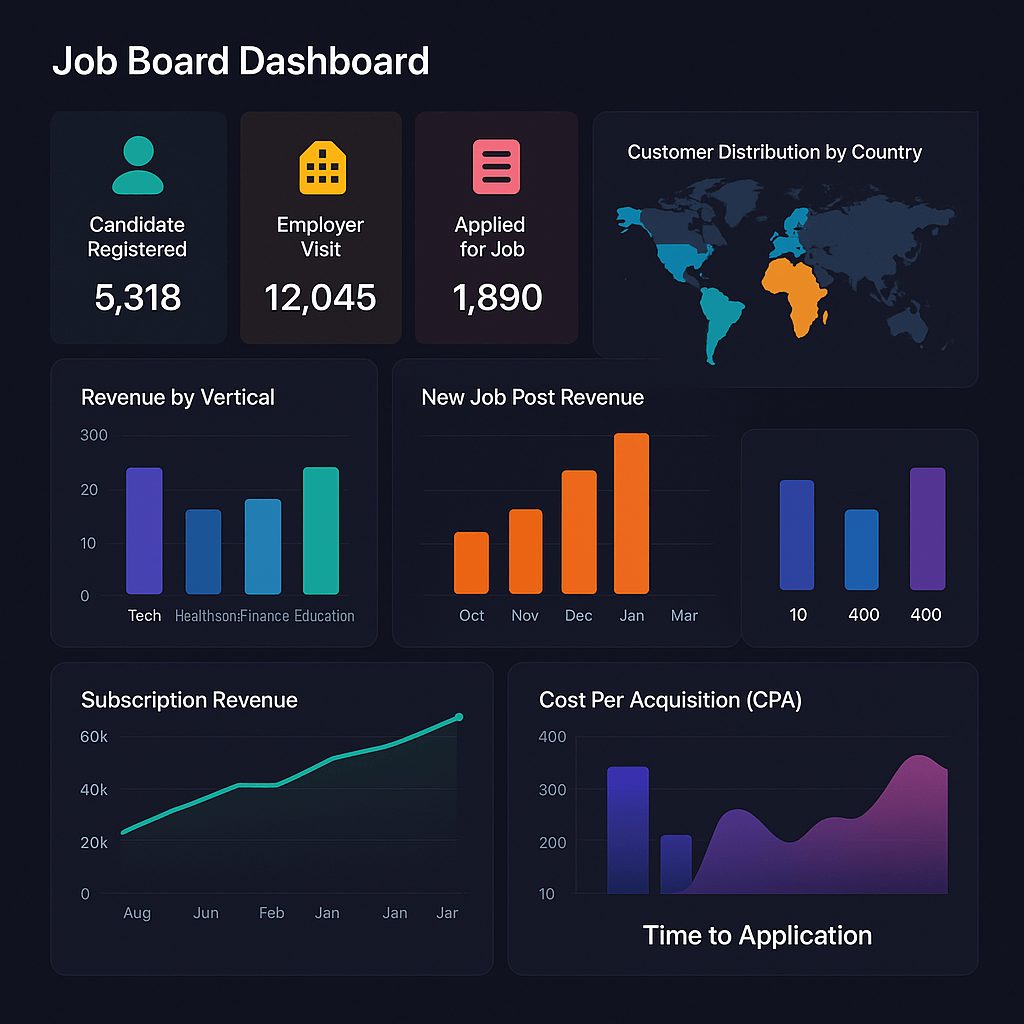
Turns out, James had no idea if his pricing model was working, if job seekers were actually completing applications, or if his marketing was reaching the right audience. He was measuring success based on vanity metrics—total visitors and sign-ups—but ignoring the real numbers that drive revenue and engagement.
If you’re running a job board, whether for a niche industry, a corporate career site, or a general marketplace, tracking the right metrics for job board success isn’t just helpful—it’s essential. Without them, you’re just throwing darts in the dark, hoping something sticks.
But don’t worry. In this guide, we’ll break down the must-track metrics for job boards, explain why they matter (without the boring jargon), and show you how to use them to boost revenue, increase job applications, and keep employers coming back.
Let’s get into it.
Also Read: How LinkedIn become a billion-dollar company
1. Setting the Right Goals
Before we jump into the nitty-gritty of metrics for job board success, let’s take a step back. What does success actually look like for your job board? Because here’s the thing—not all job boards are trying to achieve the same thing.
Some are all about maximizing revenue—selling job postings, running sponsored ads, or offering premium subscriptions to employers. Others focus on getting more applications, ensuring employers get plenty of qualified candidates. Then there are job boards that aim to build an engaged talent community, creating a hub where job seekers keep coming back, even when they’re not actively applying. And, of course, some job boards exist to drive traffic and establish authority—like a career site that’s part of a larger recruitment platform.

Let’s go back to James. After realizing his job board wasn’t performing as expected, he had to ask himself, What am I actually trying to achieve here? Sure, he wanted revenue, but that was the end goal. His immediate challenge was getting job seekers to actually complete applications—because without that, employers wouldn’t stay. So, instead of just tracking how many people visited his site, he started focusing on conversion rates—how many visitors actually turned into applicants.
This is why defining your key objective first is so important. Your metrics for job board success should align with what you’re trying to achieve. Otherwise, you might be tracking the wrong numbers and wondering why things aren’t working.
Common Job Board Goals and Their Key Metrics
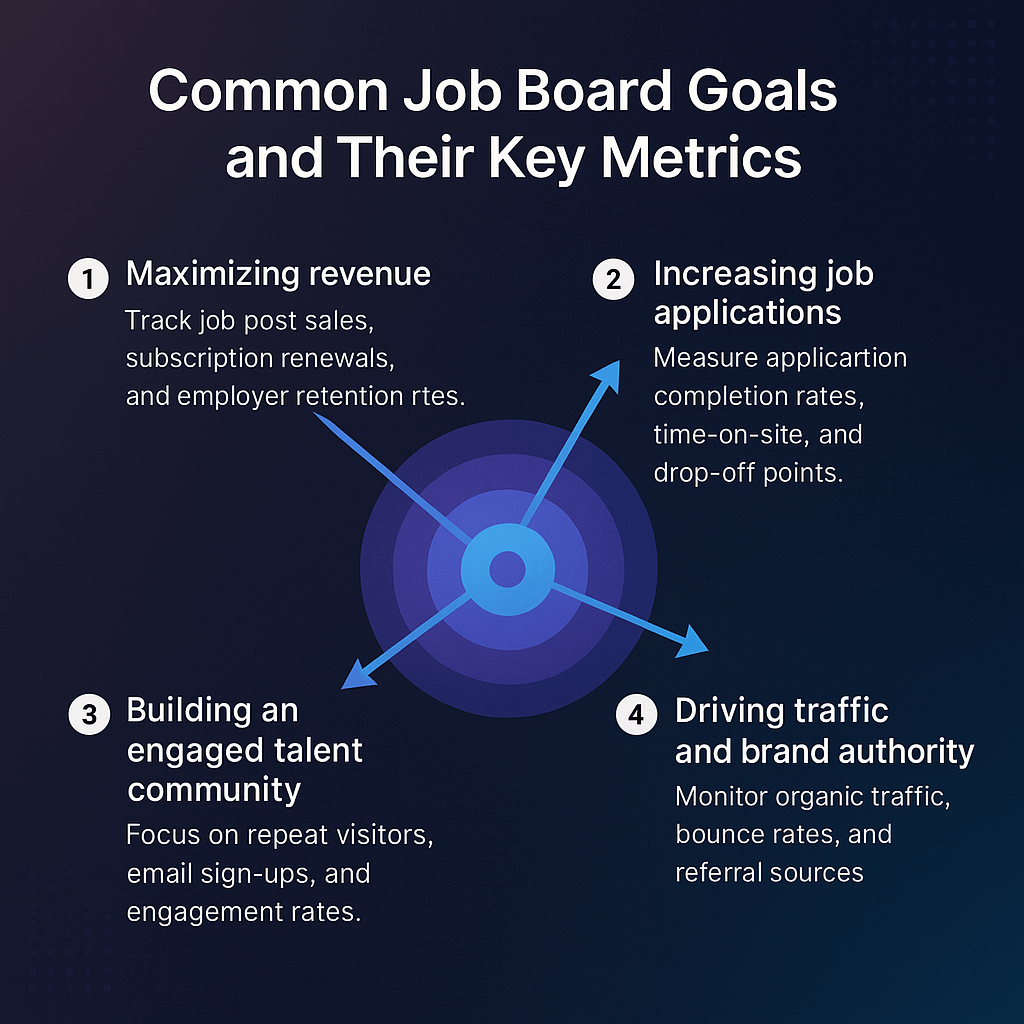
The Must-Track Metrics for Job Boards
Alright, now that you’ve nailed down your job board’s main goal, it’s time to talk numbers. But not just any numbers—the ones that actually tell you if your job board is thriving or just…existing.
Metrics aren’t just about tracking progress; they help you spot problems before they become disasters. Imagine running a job board for a year, thinking everything’s going great, only to realize your employers aren’t renewing their job posts because they’re not seeing enough applicants. Ouch.
So, let’s break down the must-track metrics for job board success, starting with the one that keeps the lights on—revenue.
1. Revenue & Monetization Metrics
No matter how passionate you are about helping job seekers and employers connect, at the end of the day, your job board is a business. And businesses need revenue to survive. Here’s what you should be tracking:
Job Post Revenue
This is the bread and butter of most job boards—employers paying to post their open positions. The question is:
- How much are employers willing to pay per job listing?
- Are they renewing and posting more jobs over time?
- Do premium job postings (e.g., featured listings) bring in significantly more revenue?
If revenue from job postings is lower than expected, it could be a sign that employers aren’t finding enough value—maybe they’re not getting enough applications or qualified candidates.
Subscription Revenue
If your job board offers recurring plans for employers (like unlimited job posts for a monthly fee), this is a critical metric to track.
- How many employers subscribe and stick around?
- What’s the churn rate—the percentage of employers canceling their subscriptions?
- Are there opportunities to increase pricing or add value to justify a higher-tier plan
Subscription-based revenue is golden because it creates predictable income—but only if you keep employers happy.
Cost Per Acquisition (CPA)
Here’s a fun question: How much does it cost you to get a new employer or job seeker to sign up?
If you’re spending $100 on ads to bring in an employer who only pays $50 for a job post, that’s a problem. If your CPA is too high, you might need to rethink your marketing strategy—are you targeting the right audience? Is your conversion process smooth?
Actionable Tip: Optimize Pricing & Employer Retention
One of the quickest ways to increase revenue isn’t just getting new employers—it’s keeping the ones you already have.
- Offer discounted bulk job postings to encourage repeat business.
- Test different pricing models (pay-per-post vs. subscriptions) to see what works best.
- Improve employer experience—better candidate matching, analytics dashboards, or post-performance insights.
2. Job Seeker Engagement Metrics
You can have all the employers in the world posting jobs on your board, but if job seekers aren’t actually applying, you’ve got a serious problem. Employers won’t stick around if their listings don’t get traction, and your job board’s reputation will take a hit.
Tracking job seeker engagement helps you understand how active and motivated your audience is. Are they just browsing, or are they actually sending in applications? Let’s break it down.
Number of Applications Per Job
This one’s simple but powerful: How many applications does each job post receive on average?
- If jobs are getting too few applications, employers will be frustrated and less likely to return.
- If some jobs are getting tons of applications while others get none, there may be a job visibility issue (are certain listings buried in search results?).
A healthy job board balances supply and demand—if jobs aren’t getting enough applicants, it’s time to optimize how listings are presented or rethink how job seekers navigate your site.
Time to Application
How long does it take for job seekers to go from viewing a job to actually applying?
- If they’re spending too much time browsing but not applying, something might be stopping them—maybe the application process is too long, or the job descriptions aren’t clear.
- If they’re bouncing off the page within seconds, the job listings might not be relevant to what they’re looking for.
A high drop-off rate before applying is a red flag that your job board might need a simpler application process or better job-matching features.
Resume Upload Rate
Uploading a resume is a strong signal of intent—it means job seekers aren’t just window shopping; they’re serious about finding a job.
If your resume upload rate is low, job seekers might not trust your platform enough or find it too much of a hassle. A high resume upload rate usually leads to better job matches and higher employer satisfaction, since recruiters get more complete profiles to review.
How to Improve Application Rates
If you notice job seekers aren’t engaging enough, try these strategies:
- Simplify the application process: Reduce unnecessary fields or allow one-click applications.
- Improve job descriptions: Ensure they’re clear, concise, and engaging (no walls of text).
- Enhance job visibility: Use smarter search filters, recommendations, and featured job slots.
By tracking and improving job seeker engagement metrics, you’re making your platform more valuable for both job seekers and employers—leading to better retention, more job postings, and ultimately, more revenue.
3. Traffic & SEO Metrics
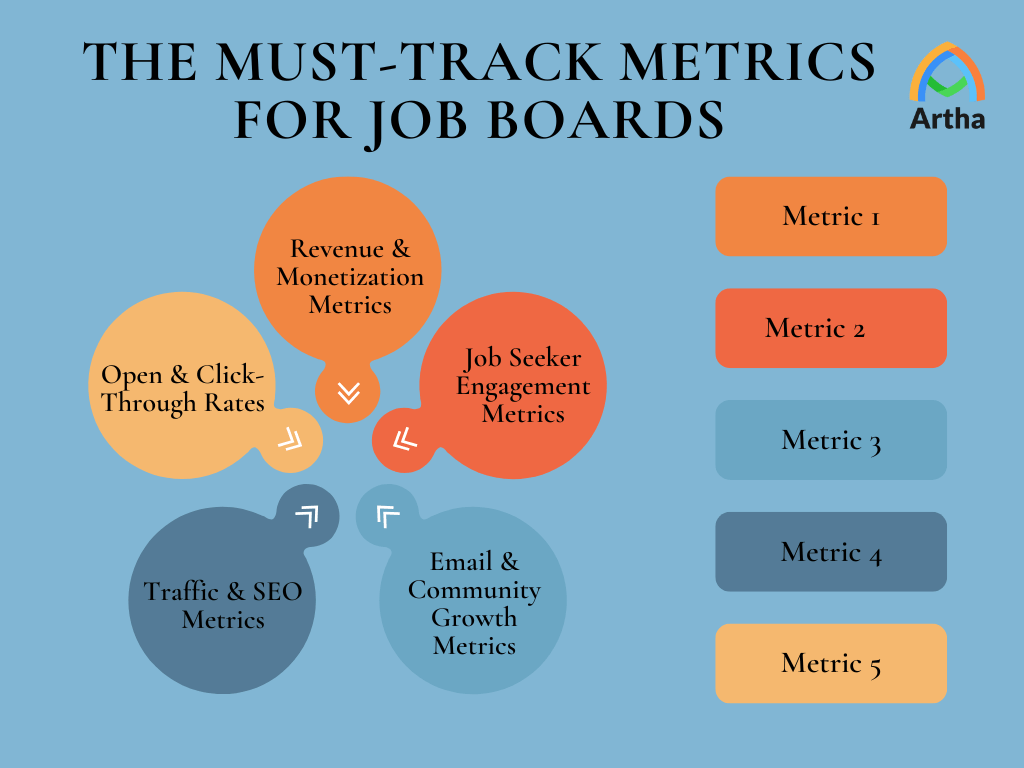
A job board without traffic is like a store with no customers—it doesn’t matter how great the products (or job listings) are if no one is walking through the door. That’s why tracking traffic & SEO metrics is crucial. These numbers tell you how people are finding your job board, how long they’re staying, and whether they’re actually engaging with the listings.
If your traffic is low, job seekers aren’t finding you. If your traffic is high but bounce rates are through the roof, they’re not finding what they expected. Let’s break down what to track.
Total Visits & Unique Visitors
How many people land on your job board every day, week, or month? Total visits show how much overall traffic you’re getting. Unique visitors tell you how many individual users are coming in (if one person visits five times, that’s five total visits but one unique visitor). If your total visits are rising but unique visitors are stagnant, it might mean your existing audience keeps coming back—but you’re struggling to reach new job seekers.
Organic Search Traffic
Are job seekers finding your board through Google? If they aren’t, you could be missing out on free, high-intent traffic from people actively looking for jobs.
If organic traffic is low, your job board might not be optimized for SEO (search engine optimization). If SEO traffic is strong but conversions are weak, you might be ranking for the wrong keywords (job seekers are landing on your site but not finding relevant jobs).
Improving job board SEO involves
- Optimizing job postings with keyword-rich titles and descriptions.
- Creating helpful content (like career tips) to rank for broader job-related searches.
- Making sure job listings are indexable by search engines (some job boards accidentally block search crawlers, preventing jobs from appearing on Google).
Bounce Rate
Bounce rate measures how many visitors leave your site after viewing just one page. A high bounce rate means users aren’t sticking around.
- If your bounce rate is high on job listing pages, the job descriptions might not be engaging or relevant.
- If your homepage has a high bounce rate, the site’s navigation might be confusing, or the job search function isn’t intuitive.
Pro Tip: Optimize for SEO and Mobile-Friendliness
SEO-optimized job descriptions help search engines (and job seekers) find your listings.
A mobile-friendly design is non-negotiable—most job seekers browse on their phones.
Speed matters—if your pages load slowly, users will leave before they even see a job listing.
Tracking these traffic and SEO metrics will help you attract more job seekers, keep them engaged, and ultimately increase applications.
4. Email & Community Growth Metrics
A strong email list and engaged community can be a game-changer for job boards. Why? Because not every job seeker lands on your site and applies right away. Some are passively browsing, waiting for the right opportunity. Some employers need reminders to post jobs. This is where email marketing steps in—it keeps your job board top of mind and nurtures both job seekers and employers until they’re ready to take action.
Tracking email & community growth metrics helps you understand if your emails are working or just getting lost in inboxes. Let’s break it down.
Also Read: How Vetted Talent Turn Their Challenge Into Success With a Job Board
Newsletter Signup Rate
Are job seekers signing up for job alerts, newsletters, or career tips? If not, it could mean:
- They don’t see value in subscribing (maybe the signup call-to-action isn’t compelling).
- The signup process is buried or confusing on your site.
- Your job recommendations aren’t personalized enough to keep job seekers engaged.
A strong job alert system can boost job seeker retention—once subscribed, they’ll keep coming back whenever a relevant job lands in their inbox.
Open & Click-Through Rates
It’s one thing to collect email subscribers, but are they actually engaging with your emails?
- Open rate tells you how many people are interested enough to open your emails.
- Click-through rate (CTR) shows if they’re taking action (like clicking on a job listing or employer profile).
If open rates are low, try A/B testing subject lines to make them more compelling. If CTRs are low, your email content might not be relevant or visually engaging enough.
Conversion Rate from Email Campaigns
The real test of an email campaign? Whether it actually drives applications or job postings.
- If emails are getting opens and clicks but not conversions, your landing pages might need better CTAs.
- If conversion rates are strong, that’s a sign your email content is highly relevant and persuasive.
Pro Tip: How to Grow & Monetize an Engaged Email List
- Offer exclusive job alerts for email subscribers.
- Send personalized recommendations based on job seeker preferences.
- Monetize emails by featuring sponsored job posts or employer branding content.
When done right, email marketing turns passive job seekers into active applicants and keeps employers engaged—helping your job board thrive in the long run.
Turning Metrics into Actionable Insights
Tracking job board metrics is great—but what really matters is what you do with that data. The difference between a struggling job board and a thriving one often comes down to how well they interpret and act on their metrics.
Think of it like a fitness tracker. Just knowing your step count won’t make you healthier—you need to actually adjust your routine based on the data. The same goes for your job board. If you see low applications, high bounce rates, or weak employer retention, you need to dig deeper and make changes.
How to Analyze & Interpret Your Data for Growth
Look for Patterns, Not Just Numbers
If your traffic is high but job applications are low, your job descriptions might need improvement.
If employers aren’t returning, your candidate quality might not be meeting their expectations.
If your bounce rate is high, your site might not be mobile-friendly or easy to navigate.
Compare Your Metrics Over Time
- Instead of just looking at one month’s data, track trends over 3-6 months.
- Are your application rates improving or declining? Are employers posting more frequently?
- Segment Your Audience for Deeper Insights
- Are certain industries performing better than others?
- Do job seekers from specific traffic sources (Google, email, social media) apply more than others?
Case Study: Johnson & Hill Staffing’s Website Overhaul

Johnson & Hill Staffing, a woman-owned business in Western Massachusetts and Northern Connecticut, recognized the need to modernize their online presence. They embarked on a comprehensive website redesign with the following objectives:
- Reflect Updated Branding: Align the website with their recent rebranding efforts.
- Enhance User Experience: Improve navigation and accessibility for both job seekers and employers.
- Optimize for Mobile Devices: Ensure the site is mobile-friendly to cater to the growing number of mobile users.
The results were remarkable
- Increased Job Board Traffic: The new site led to a 771% increase in job board traffic.
- Industry Recognition: The website earned a Grand Prize at the American Staffing Association’s Genius Awards.
Tools & Resources to Track Job Board Metrics
Having the right tracking tools can make the difference between guessing and knowing what’s working on your job board. Whether you want to measure traffic, conversions, or employer retention, data-driven decisions start with the right tools.
Here’s a look at some essential tools and how they help you track job board performance.
1. Google Analytics: The Foundation of Job Board Tracking
Google Analytics (GA4) is a must-have for any job board. It helps track:
- Total Visits & Unique Visitors: How many people are landing on your site?
- Bounce Rate & Session Duration: Are users engaging with your job listings or leaving too soon?
- Traffic Sources: Are users finding your job board through Google, social media, or referrals?
- Conversion Tracking: How many visitors complete key actions, like applying for a job or signing up for job alerts?
Pro Tip: Set up custom events in GA4 to track actions like job applications, resume uploads, and employer sign-ups.
2. SEMrush & Ahrefs: SEO and Competitive Insights
If you want to increase organic traffic, you need a strong SEO strategy. Tools like SEMrush and Ahrefs help track:
- Keyword Rankings: Are your job listings ranking for the right search terms?
- Backlinks & Competitor Analysis: How does your job board compare to others in your niche?
- On-Page SEO Suggestions: Fix issues like slow loading speed or missing meta descriptions.
Pro Tip: Use SEMrush’s Content Gap Analysis to discover keywords competitors rank for that you don’t.
3. Job Board Platforms with Built-in Analytics
If you’re using job board software like Artha, Niceboard, SmartJobBoard, or JobBoard.io, these platforms often include built-in analytics dashboards with:
- Application Tracking: See which job postings get the most applications.
- Employer Engagement: Track how many employers return to post jobs.
- Job Seeker Activity: Monitor sign-ups, resume uploads, and saved jobs.
Pro Tip: Many platforms allow email alerts for key metrics—set them up to monitor sudden drops or spikes in activity.
4. Automating Reporting for Better Insights
Manually pulling reports takes time—but automation makes it easy to stay on top of your job board’s performance.
- Google Looker Studio: Create real-time dashboards pulling data from Google Analytics, Search Console, and job board platforms.
- Zapier: Automate reports by connecting your job board software to Google Sheets, Slack, or email alerts.
- Tableau & Power BI: Advanced tools for deeper data visualization and trend analysis.
Pro Tip: Set up weekly or monthly automated reports to track changes and spot growth opportunities faster.
Conclusion
If you’re not tracking your job board’s performance, you’re flying blind. The right metrics help you understand what’s working, what’s not, and where to improve. By focusing on revenue, job seeker engagement, traffic & SEO, employer retention, and email marketing, you can fine-tune your strategy and drive better results.
Success isn’t just about collecting data—it’s about using it. Whether it’s optimizing job descriptions, improving site navigation, or refining pricing strategies, small adjustments based on insights can lead to big wins.
The best time to start tracking these key metrics? Right now. Don’t wait until traffic drops or employers stop posting—get ahead of the game. Download our free Job Board Analytics Checklist to make sure you’re tracking the right KPIs, or book a demo to see how analytics tools can help you automate reporting and grow your job board faster.




